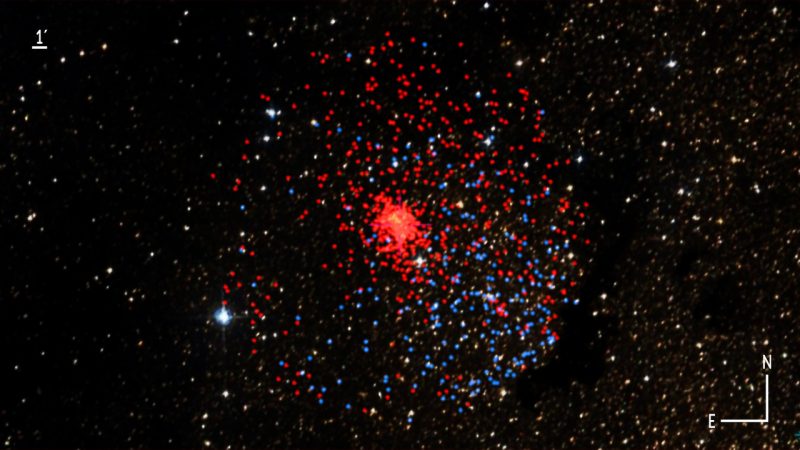
Westerlund 1 is the most massive young star cluster in our Milky Way galaxy. It’s now thought to contain enough mass to make 100,000 stars like our sun. These stars are less than 10 million years old. We can’t see this cluster very well. It sits behind a cloud of dust. But on May 25, 2022, astronomers said that they’ve managed to peer through the dust. They said they’ve estimated the cluster’s distance and analyzed its stellar population.
The cluster consists of a wide range of massive stars, including O-type giants and supergiants, red supergiants, extremely luminous B-type hypergiants and yellow hypergiants. The scientists published their study of Westerlund 1 on April 1, 2022 in the peer-reviewed journal Astronomy and Astrophysics. The study was later updated on May 24.
Learning more about Westerlund 1
The scientists selected target stars in the cluster and then used Gaia to determine their distances. Lead author Ignacio Negueruela of the University of Alicante said:
Westerlund 1 is, without a doubt, one of the most interesting objects in our galaxy. Due to the enormous amount of dust along our line of sight, even a telescope as advanced as Gaia has difficulty in providing high-quality data. It has been necessary to apply complex statistical processing to the observations in order to give such an accurate value for the distance. But Gaia has provided us with much more information, as it has revealed the true size of the cluster and allowed us to identify stars in the cluster that were not known before.
Westerlund 1 is the most massive young cluster
Co-author Emilio J. Alfaro of the Institute of Astrophysics of Andalusia explained that the cluster is not just the largest in the galaxy but in most of the local universe:
The cluster is located about 13,000 light-years from the sun, which implies that its mass is closer to 100,000 solar masses than to a few tens of thousands, making it the most massive young star cluster in the Local Group, except for R136 in the Large Magellanic Cloud.

A previously unknown spiral arm segment?
The scientists discovered an even closer large concentration of blue stars. These stars are about 6,500 light-years from the sun. This could be a previously unknown star-forming complex or a spiral arm segment. Alfaro said:
The detection of a concentration of blue stars, with an angular motion very close to that of the cluster, but at a smaller distance, requires a more detailed study to show its nature and origin. This direction of the galactic plane is very rich in young stars, and the determination of the distance of Westerlund 1 also indicates the probable position of one of the inner spiral arms, a fundamental data to understand the complicated spiral structure of the Milky Way.
Westerlund 1 versus globular clusters
The only objects in the galaxy that have a similar mass – between 10,000 and 1 million solar masses – to Westerlund 1 are globular clusters. But globular clusters are ancient stars some 12 billion years old, while Westerlund 1 is quite young. The scientists hope that studying how Westerlund 1 formed could provide insight to understanding how the most massive clusters form today and why they are so rare.
Ricardo Dorda, a researcher at the Institute of Astrophysics at the Canaries, said:
All the stars we can see in this cluster are much more massive and luminous than the sun. Some are so huge that, if we were to place them at the center of the solar system, they would almost reach as far as the orbit of Saturn. In fact, one of them is a candidate to be the largest star we know of. The importance of the cluster lies in the fact that all these extreme objects can be associated with the population they come from.

Bottom line: Scientists have gotten a better look at Westerlund 1, the most massive cluster in the galaxy. They learned more about its size and distance.











